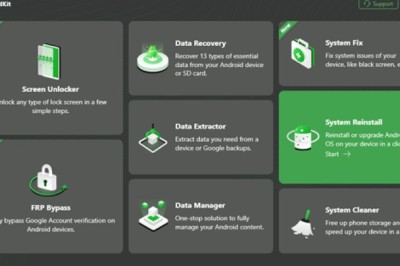views
The Food and Drug Administration (FDA) has approved various pharmaceutical drugs, known as sedatives, to help people with sleep disorders over the years. With all the different sedative drugs on the market today, it’s worth asking whether some drugs are more dangerous than others and why some are far less popular than they once were. Here’s what you should know about the dangers of sedative drugs.
What Are Sedatives?
Understanding the precise definition of sedative drugs can be a bit tricky since sedatives include drugs known for their sleep-inducing qualities and other drugs typically prescribed for pain management. This is because some use the phrase sedative to describe all drugs that fall into the depressant category. However, it is better to describe sedative drugs among the common category of drugs typically used to treat insomnia and other sleep disorders, although even these drugs can be prescribed for a wide range of symptoms.
When it comes to the list of the most popular sedative drugs, the drug types that make up this list are barbiturates, benzodiazepines, and Z-drugs. To understand why each drug was popularized in the pharmaceutical market, it’s important to know how and why they replaced their predecessors. In the 1860s, barbiturate drugs became widely known as a sedative-inducing medication, enjoying widespread use for a century. This drug type could be used for anxiety, sleep disorders, and muscle spasms and is probably most known under the drug name Nembutal.
What Makes Sedatives So Dangerous?
Despite the fact that barbiturates were marketed as completely safe drugs, the research and test cases related to this drug could not be denied, leading to their decline in popularity and the need for a new, safer sedative. In the middle of the 20th century, benzodiazepines hit the market as a safe alternative to barbiturate drugs. Once people began to see the addictive nature of barbiturates and the long-term abuse that many users of the drug were experiencing, benzos were considered by many as a worthy replacement.
Non-Barbiturate Sedatives
In fact, enthusiasm around this new type of drug was so popular that it became among the most commonly prescribed drugs and widely used of all time. What made these different from barbiturates was the claim that benzos posed a lower risk of abuse and a far less dangerous scenario in the event of an overdose. While this seemed to be the case early on in benzo use, people began noticing that long-term use of these drugs carried the same abuse potential that was a cause for concern with barbiturates.
Non-Benzodiazepine Sedatives
Pharmaceutical companies responded with a new class of drugs, known as Z-drugs, that are referred to as “non-benzodiazepine sedatives.” While the idea of calling sedatives “Z-drugs” may sound like a clever way to describe drugs that help people fall asleep, the Z actually has nothing to do with sleeping.
Instead, it is meant to describe the drugs that either begin with Z or include Z in their name. The most popular examples of these drugs are zaleplon, eszopiclone, and zolpidem. Many people would not recognize these drug names, but they would quickly recognize the brand names that are behind these drugs: Sonata, Lunesta, and the most popular of them all: Ambien.
In benzodiazepines and Z-drugs, one particular brand has seemed to become more popular. For benzodiazepines, Xanax is by far the most widely used and widely known; for Z-drugs, Ambien carries that same level of popularity and recognition. Unfortunately, both drugs fail to truly replace their predecessors, and their recognition has a lot to do with their notable abuse potential.
Ranking the Benefits and Risks
If you were to rank the danger of these drugs, one place to look is the United States Drug Enforcement Administration (DEA)’s drug schedule. The federal agency classifies drugs from Schedule V to I, with V being the lowest potential for abuse and I being the highest. According to its categories, barbiturates are mostly in the Schedule III class, but some examples also fall into schedule II and IV drugs. Compared to barbiturates, benzodiazepines and Z-drugs are Schedule IV, generally making them a safer option.
However, these drugs’ risk of injury and/or death regarding their side effects should be considered. This is where the FDA’s guidance should also be reviewed when thinking about the safety and potential danger of these drugs. While the DEA’s scheduling seems to put barbiturates in a higher category of abuse, the FDA includes its black box warning label on benzodiazepines and Z-drugs like Ambien. This warning means the risk level is very high compared to the potential benefits of using these drugs, including the serious risk of adverse reactions and/or death. In contrast, some barbiturates do not carry this black box warning, even though the DEA ranks their risk level higher.
Should You Use Sedatives?
While this information can seem conflicting, the important thing to take away from this history of sedative drugs is the danger of mistaking drugs to be much safer than they actually are. This same mistake has been made with barbiturates, benzodiazepines, and Z-drugs. At the end of the day, there is no such thing as a completely safe sedative drug. While each person can expect to handle certain sedative drugs differently, there is enough published evidence from the DEA and the FDA to remind us that the benefits of these substances rarely outweigh their risks.
If you or someone you know is addicted to any of the sedative drugs mentioned here, it’s important to know that addiction is a serious condition, but it can be treated. Start your path toward recovery today and reach out to medical professionals who can help you each step of the way.
Sources
Department of Justice/Drug Enforcement Administration. (2020 April). Depressants. Retrieved https://www.dea.gov/sites/default/files/2020-06/Depressants-2020.pdf
Delphi Health Group. (n.d.). Guide to Benzodiazepine Addiction and Treatment. Retrieved https://delphihealthgroup.com/benzodiazepines/
Delphi Health Group. (n.d.). Sedative Addiction. Retrieved https://delphihealthgroup.com/sedatives/
Psychiatric Times. (2007 August 1). Risk Versus Benefit of Benzodiazepines. Retrieved https://www.psychiatrictimes.com/view/risk-versus-benefit-benzodiazepines
Drugs.com (2022 August 29). Insomnia Treatments: The Latest on Z-Drugs and DORAs. Retrieved https://www.drugs.com/slideshow/insomnia-treatment-zdrugs-doras-1072
Ambien. (n.d.). Ambien Homepage. Retrieved https://www.ambien.com/
United States Drug Enforcement Administration. (2018 July 10). Drug Scheduling. Retrieved https://www.dea.gov/drug-information/drug-scheduling
Department of Justice/Drug Enforcement Administration. (2020 April). Barbiturates. Retrieved https://www.dea.gov/sites/default/files/2020-06/Barbiturates-2020_0.pdf
Department of Justice/Drug Enforcement Administration. (2020 April). Benzodiazepines. Retrieved https://www.dea.gov/sites/default/files/2020-06/Benzodiazepenes-2020_1.pdf
Department of Justice/Drug Enforcement Administration. (2017). Drugs of Abuse: A DEA Resource Guide. Retrieved https://www.dea.gov/sites/default/files/drug_of_abuse.pdf
FDA (2011 October). Guidance for Industry: Warnings and Precautions, Contraindications, and Boxed Warning SEctions of Labeling for Human Prescription Drug and Biological Products. Retrieved https://www.fda.gov/media/71866/download
FDA. (2020, October 2). FDA Requiring Boxed Warning Updated to Improve Safe Use of Benzodiazepine Drug Class. Retrieved https://www.fda.gov/drugs/drug-safety-and-availability/fda-requiring-boxed-warning-updated-improve-safe-use-benzodiazepine-drug-class
FDA. (2022, February 18). FDA adds Boxed Warning for risk of serious injuries caused by sleepwalking with certain prescription insomnia medicines. Retrieved https://www.fda.gov/drugs/drug-safety-and-availability/fda-adds-boxed-warning-risk-serious-injuries-caused-sleepwalking-certain-prescription-insomnia
FDA (2007 September 18). FDA Approved Labeling text for NDA 793/S- 025 (Butisol Sodium oral soln). Retrieved https://www.accessdata.fda.gov/drugsatfda_docs/label/2007/000793s025lbl.pdf






















Comments
0 comment